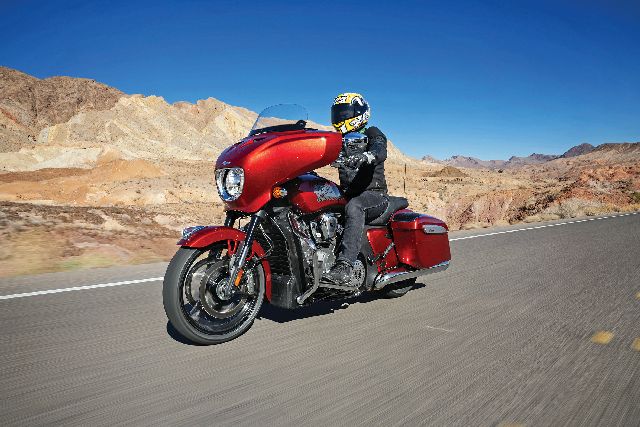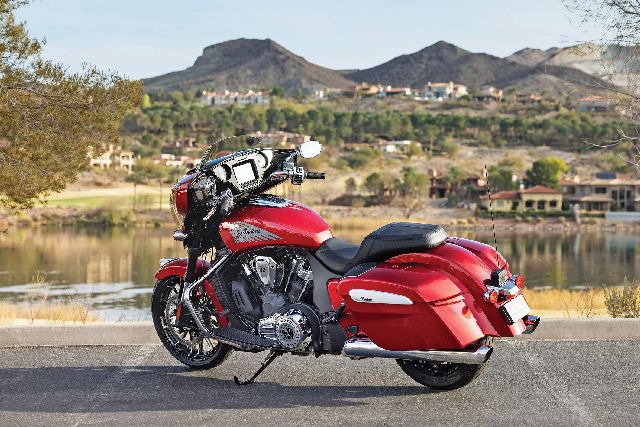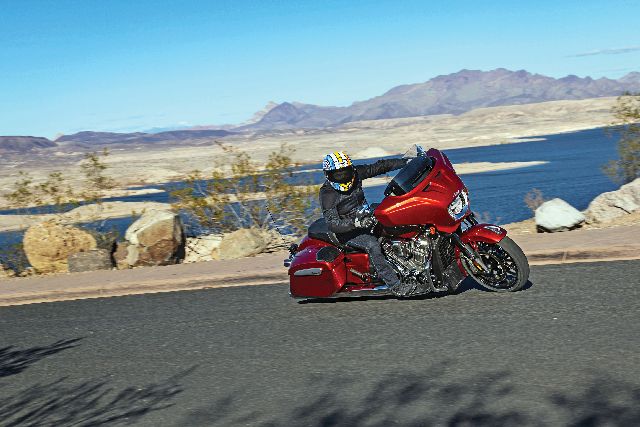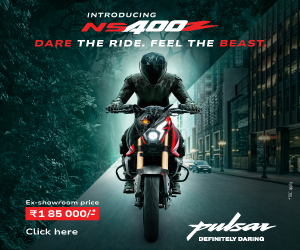Relaxed into the Chieftain’s plush seat, an arrow-straight road stretching for miles into the distance, I could not have been happier or more comfortable. With the relatively small, electrically adjustable screen fully upright, I could ride with my visor wide open at 100 km/h, making me wish I had packed an open-face in my luggage. Cruise control set, music clear at just half volume, every so often checking the route ahead on the sat-nav… I mainly concentrated on enjoying the stunning views of the Valley of Fire State Park. The chaps at Indian told me that some riders regularly push out 500 to 800 km in a day on their Chieftains and I can see why.

When it is cruising, everything feels optimized. Just enough cooling air flows underneath the ’bars to the rider, which, in 20-degree temperature, is perfect. The suspension is on the soft side but is not overly soft, the ’bars have good low-speed leverage but are not too wide, and the footboards are exactly where you want them to be.
At a legal-ish cruising speed, the motor is having a gentle jog, with the revs hovering at around 3,000 rpm or below, depending on your speed. The 112 is turbine smooth and hardly working. Acceleration in top gear is more than adequate, but when you want that extra kick, cog back to fifth or fourth gear and let all the twin’s horses find their way to the road. There is serious grunt available from just 2,000 rpm, while peak torque is at just 3,800 rpm. Unlike most bikes of the cruiser persuasion, the Chieftain will happily rev past 6,000 rpm, blending the best of low-rpm drive and lively acceleration through the upper revs.

From a standing start, you can simply short-shift and enjoy the tidal wave of torque or dump the clutch and give the belt final drive and traction control (TC) a proper workout. With the TC removed, the 112 will send the rear Metzler Cruisetec spinning, even in the dry. Do not be fooled, this bike is quick off the mark, especially once you have flicked into Sport mode with its more aggressive throttle map.
In Nevada’s desert, corners are few and far between, which I thought was probably a good thing as this might be where the new Indian would struggle. The suspension set-up is relatively basic with non-adjustable upside-down (USD) forks up front and only hydraulic preload adjustable on the rear shock. Wheel diameters, meanwhile, are 19-inch front and 16-inch rear—but it all works.

The suspension holds the chassis and copes with the Chieftain’s 366 kilos (dry) even over undulations and bumps. It is stable and reassuring, while the rear refuses to sit down like an obedient dog when that immense torque output lets rip, and communication from the Metzelers is decent for this type of bike. All of which encourages you to have some fun when you finally find a corner to play on, the only hint of complaint being when the footboards deck out. That said, with the maximum lean angle quoted at 31 degrees, ground clearance is far better than some of the competition. Increase the preload on the rear and you will get even more clearance, depending on the weight of the rider, luggage, and pillion rider.
Brakes are usually the Achilles heel of cruisers but not so with the 2025 Chieftain PowerPlus 112. Twin Brembo radial stoppers up front pair with 320-millimetre discs. The front and rear systems are linked and supported by lean-sensitive ABS, which is not noticeably obtrusive for this type of bike. The front brake activates the rear and vice-versa and, if you want to be lazy, you can just rely on the rear pedal which automatically activates the front. It is an impressive system that is more than capable of handling that sizeable mass of motorcycle.
By the lunchtime of our test, the new Indian felt like a bike I had owned for years, while its detailed approach to making life easy for its rider came to the fore. When stationary in traffic, the rear cylinder deactivates automatically to save fuel and reduce heat reaching the rider and pillion. The linked brakes are not linked at low speeds to make low-speed manoeuvring easier. The automatic hill control makes life on a large bike much less stressful. The rear panniers open easily from the top via a simple push button and are more capacious than they appear—there is even central locking and a useful USB charger at the front. It seems like Indian have thought of everything barring a reverse gear.

In the warm afternoon, we cranked out more miles. The rear collision warning and blind sport detection work well—there is a clear indication on the dash or in the mirrors if a vehicle is too close—although when riding in a group, it became a little distracting. Thankfully, you can turn this and other safety aids on and off on the move from the touchscreen dash.
In the middle, seemingly, of nowhere, we also had the opportunity to stretch its legs. The 112 revs freely to its limiter at about 6,250 rpm. Make full use of the power and the Chieftain rushes past 160 km/h before hitting a soft speed limiter at an indicated 175 km/h, which feels a little strange given that it is still accelerating, utterly stable, and clearly capable of more.
At a more realistic 135 to 145 km/h, the bike feels smoother and more relaxed than some of the air-cooled competition. There is still plenty in reserve for overtakes, even, I suspect, when fully loaded and all the while the exhaust sounds pleasingly businesslike.
Usually, after a long test-ride you are happy to be back at the hotel and quaff a cool beer, but this was not the case with the Chieftain. I was fresh and not all fatigued. I had found a radio station that played classic rock from my beloved 1990s and I wanted to ride further into the wilds of Nevada. Batting out another 22.7 litres of fuel would not be a problem, the dash even looked cool dusk. We averaged 15.3 km/l, but at times we were riding hard.
As I said at the beginning, there is a bike for every occasion and riding in Fire State Park, the sublimely good-looking Indian was the perfect partner. I am sure all its qualities will also work as well on Brighton’s seafront as on Scotand’s North Coast 500. Yes, starting at £26,895 (Rs 29.58 lakh) as it does, it is expensive and can easily be spec’d up to £30,000 (Rs 33 lakh), but that is only on a par with the competition. If you want a big bagger, you have to pay big dollar.
I did not have high expectations of Indian’s new Chieftain. The on-paper figures were impressive and the manufacturer has secured multiple championships in the King of the Baggers series, but big baggers usually fall short in some areas—technology, brakes, and handling especially. Not this time. The new Chieftain surpassed my expectations and more.
The new PowerPlus 112 V-twin has an easy-to-ride vibe that features an ocean of low-down torque from virtually no revs. It then picks up in a tree-uprooting mid-range before driving hard towards its red-line. It has class-leading performance.
Handling is impressive for this type of bike. It has unflappable stability and is easy to ride at a brisk pace. Ground clearance is as good as we have seen in this class while the linked Brembo stoppers are strong and manage the bike’s weight efficiently.
Sophisticated, state-of-the-art rider aids such as lean-sensitive ABS and collision and tail-gate warning and blind spot detection have moved to the cruiser sector, which could be a bit unwelcome or even intimidating for air-cooled traditionalists. But Indian have made them easily accessible.
Finally, all that oomph and ability is wrapped in stunning styling, with a high level of finish that elevates rider comfort to a new level. Indian certainly have not forgotten their core values: “make it simple, keep it clean and timeless to create the world’s most desirable motorcycle”.

Need to Know – Indian Chieftain PowerPlus Limited
Price: Rs 41.25 lakh (ex-showroom)
Engine: 1,834 cc, water-cooled, four-valve, V-twin
Transmission: Six-speed, belt final drive
Max Power: 126 hp at 5,600 rpm (rpm estimated)
Max Torque: 181 Nm at 3,800 rpm
Top speed: 175 km/h (limited)
Tyres: 130/60 B19 front, 180/60 R16 rear, Metzeler Cruisetec
Brakes: Twin 320-mm discs front, 298-mm disc rear, Bosch cornering ABS
Seat height: 672 mm
Ground clearance: 137 mm
Fuel capacity: 22.7 litres
Weight: 382 kg (wet, no fuel)


Leave a Reply